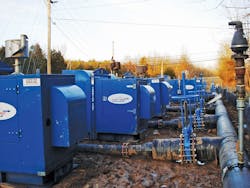Bypass on the Run
To quote President Barack Obama’s State of the Union speech on Jan. 25, 2011: “Our infrastructure used to be the best, but our lead has slipped… Our own engineers graded our nation’s infrastructure: They gave us a ‘D.’”
Cub Run Gravity Delivery System
The Upper Occoquan Sewer Authority, along with the Fairfax Water Authority and Fairfax Parks Authority, long recognized the validity of the president’s statement and hired contractor S.J. Louis Construction Co. to replace approximately 28,000 ft of main gravity sewer lines. This improvement addressed wastewater quality management needs relating to the acquisition, expansion and rehabilitation of deteriorating facilities and systems. During the removal and replacement process, the sewage still has to flow. Thompson Pump’s expertise was tapped to execute this 18-month project located in Centerville, Va., an upscale suburb of Washington, D.C.
Beginning in December 2009, Thompson Pump representatives Tucker Lamontagne and Rob Hayden of the local Baltimore-Washington branch began bypass for the first of 10 phases of the Cub Run gravity delivery system improvement project.
A River of Challenges
Multiple bypass pump systems had to be utilized to temporarily divert current flows around the pipe section being replaced—all without stopping the normal flow, thus ensuring continuation of sewage service during construction. To accomplish this, temporary pumps were installed upstream from the pipe being replaced and sewage was bypassed to a downstream section of the pipeline that was still active. To stop the regular flow of the pipeline, temporary plugs were installed in the line before the section that would be replaced, thus diverting the flow to the temporary pumps.
Though the overall goal is to replace more than five miles of pipe, the challenges lie in the details. The main sewer line has multiple tie-ins from smaller lines, there are several large creeks and river crossings to navigate, and the overall project is located in a floodplain. Additionally, the majority of the site is not accessible via traditional transportation (e.g., a work truck). The contractor also had to complete a four-year job in less than two years.
“If we received more than 3 in. of rain within a few days, the site would flood and turn into deep mud,” Lamontagne said. “Floodwaters would cover the manholes.”
A Planner is a Winner
Thompson Pump creatively attacked these enormous challenges. Off-road vehicles, such as the John Deere 4x4 utility Gator, have provided key site transportation. A Thompson light tower remains on site to ensure proper lighting during darker hours of operation.
Detailed preparation of equipment and manpower was required for quick response. Full-service preventative maintenance is performed, and Thompson Pump is on site every day. With the help of the contractor, pumps have been placed as needed on higher-grade embankments—all without disturbing the surrounding environment. Stream crossings were constructed carefully so as not to impede the flow of the stream and its tributaries.
“Through multiple floodings and challenges, Thompson Pump has maintained successful bypass operations with no interruptions,” Lamontagne said. The overall project was divided into 10 core bypass phases. Each phase includes the main bypass, plus multiple lateral bypass tie-ins. Each phase has required varying pump quantities and sizes. All of them required multiple main bypass and lateral bypass pumps with redundant backup pumps for precaution and auxiliary fuel tanks to assure long run times. Each backup pump is outfitted with an auto-dialer notification system that would provide Thompson Pump first notification of the pumps’ activities.
Thompson’s Enviroprime sewage pumps were employed with automatic liquid-level controls. The Enviroprime is a priming system that allows for automatic self-priming while providing the environmental advantage of preventing fluid blow-by (spillage) during priming and operation unlike other current technologies. Additionally, Thompson Pump Arctic Knight technology was used to assure continuous pumping during temperatures as cold as -40F while eliminating the traditional problems of operating pumps in cold climates (e.g., frozen liquids in the pump housing).
The bypass for each phase experienced an average of 15-ft suction lift. Levels of peak and low flows varied from 6,900 gal per minute (gpm) to 27,000 gpm for the main sections, and bypasses varied from 350 gpm up to 10,000 gpm for the lateral sections. Almost a mile of discharge pipe ran the length of the project. Smooth Execution
Phase I employed five Thompson 8-in. units as primary pumps at the main trunk line. The three lateral lines were covered by two 6-in. pumps. Phases II through VI engaged four Enviroprime 18-in. primary pumps on the main lines and various sizes, including 4-, 6-, 8- and 12-in. units to handle the lateral tie-ins.
Currently on Phase VI, more than 20 pumps have allowed for coverage of the high peak flows, while simultaneously handling the lighter flows. Phases VII and VIII will be addressed by employing five Enviroprime 18-in. primary pumps and two pumps each for the four lateral tie-ins, for a total of 13 pumps. Phases IX and X will require a variable amount of pumps depending on the progress.
In addition to the diesel-driven pumps, Thompson fused and installed the entire initial system of 18-in. high-density polyethylene (HDPE) pipe. Dual discharge lines of HDPE were divided into sections of approximately 4,000 to 5,000 ft. The lateral HDPE pipes tied into the main 18-in. discharge HDPE lines via “T” sections.
“Innovative ideas and good planning have made these phases of the ongoing Cub Run project a success,” Lamontagne said. “The contractor has been so pleased with our pump capabilities and fuel efficiency [that] he’s already purchased three of our 18JSCJ Enviroprime sewage pumps for this and future projects.”
Download: Here
